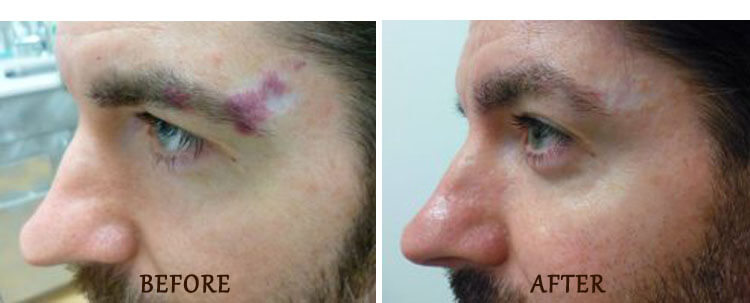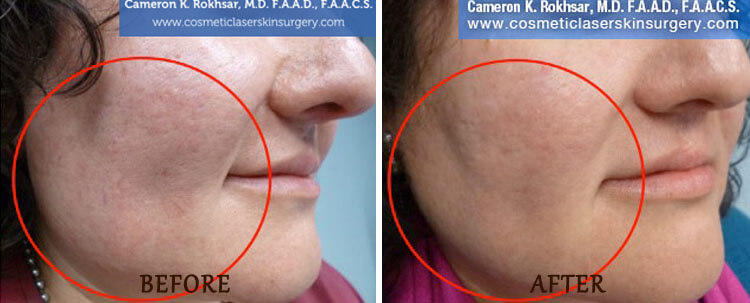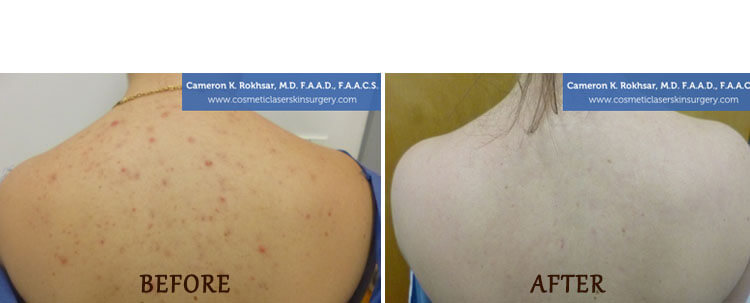Vbeam Laser Broken Facial Capillaries Treatment in New York
The VBeam Perfecta laser is designed to treat redness, rosacea, birthmarks, vascular lesions, scars, face veins, facial, neck, and chest redness without damaging the surrounding tissue and skin surface. The VBeam laser produces1 an intense light that selectively destroys the blood vessels within the area that are causing the unsightly discoloration. Broken capillaries on the face are most often caused by genetics, but sun exposure, spicy foods, alcohol, cold, hot and windy weather can also cause flushing. It is important to determine if this is broken facial capillaries, or if it is external environmental factors that cause temporary redness.
Rosacea and Vbeam Laser
Rosacea2 is a common skin condition that results in spider vein-like blood vessels broken across the face, with an overall general redness on the face. It may also result from adult acne.
The VBeam laser can emit precise waves of energy into each targeted vein. As time passes, the clogged vessel is naturally absorbed by the body and no longer causes the skin to appear red.
What is Unique About Vbeam?
Although numerous creams and topical treatments are available that claim to ease the redness, lasers are the most efficient way to treat broken capillaries. Since the VBeam is the most advanced pulsed dye laser currently available on the market, the appearance of broken capillaries can be greatly reduced and in most cases, eradicated. VBeam focuses its energy on the delicate cheek, nose, and chin skin of the face. There are a few treatments necessary to reach optimal results, but results can be seen as soon as the first session.
Click here to see our page on Rosacea and Broken Facial Capillaries
Vbeam: Before and After
*Results may vary.
Vbeam FAQ
What is the Vbeam used for?
Vbeam lasers are specifically designed to treat vascular issues which cause redness in the skin. Various conditions include rosacea, port-wine stain birthmarks, redness flush and irritation from acne, fresh stretch marks, facial and leg veins (varicose veins), hemangiomas, and angiomas.
How does the Vbeam laser work?
The laser works by administering different wavelengths to target unusual pigmentation caused by blood vessels or other discoloration caused by acne.
Can the Vbeam improve skin texture?
Skin texture improvements are a secondary effect of Vbeam laser treatments. Specifically, the laser is designed to treat blood vessels, but the laser light also heats the deeper layer of the skin, the dermis. A new and improved skin texture is achieved by stimulating collagen production in the dermis.
Is Vbeam Laser Permanent?
Vbeam laser results can be permanent, the longevity of your results depends on lifestyle choices and the condition of your skin. You can discuss any concerns with Dr. Rokhsar.
What is a Vbeam laser?
The Vbeam laser is a medical device that emits a single wavelength of light, and is commonly used in dermatological applications to safely and effectively treat a range of skin issues related to blood vessels and pigmentation. The Vbeam laser is a type of pulsed dye laser (PDL) that uses gentle light bursts to target vascular and pigmented discolorations, including rosacea, sun spots, age spots, freckles, port wine stains, spider veins, and broken capillaries.
The Vbeam laser emits laser energy that is absorbed by the oxyhemoglobin in the blood vessels, which heats the problem spots evenly in micro-bursts, resulting in a firmer skin texture. The laser’s quick pulses of laser energy are colored using a special dye to increase their effectiveness for a variety of common skin issues.
The Vbeam laser is generally safe and effective for vascular lesion treatment, red acne scar removal, skin rejuvenation, red stretch mark removal, rosacea, broken capillaries, birthmarks including hemangiomas and port wine stains, under eye veins, leg veins, and many other skin disorders. Dr. Rokhar can use the Vbeam laser safely in every skin color including asia, black and Hispanic skin on any body area.
How much is Vbeam laser treatment?
The cost of Vbeam laser treatment depends on factors such as the location of the doctor’s office, their level of experience, the size of the treatment area, the number of sessions needed, and whether discounted packages are available if multiple sessions are paid for upfront. The cost may vary depending on the location, the individual patient’s needs, and the doctor’s pricing policies.
How many Vbeam treatments are needed?
The number of Vbeam treatments needed varies depending on the severity and type of the condition being treated and individual response to therapy. For the treatment of veins or cherry angiomas, patients may see final results within 1-2 weeks after one treatment. However, most people typically require two to five sessions, spaced two to four weeks apart, for optimal results in treating other conditions such as rosacea, port wine stains, broken capillaries and other vascular conditions. Some patients may respond after one or two sessions, while others may require more.
How to reduce swelling after Vbeam?
Swelling is a common side effect of the treatment, but there are several ways to reduce it.
Applying ice packs is one way to help reduce swelling. It is recommended to apply the packs for about 10 minutes every hour on the first day after treatment. Some antihistamines like Allegra or Zyrtec may also be prescribed for the next 5 days to help minimize the swelling. Arnica Montana may be taken to encourage healing and to alleviate bruising or swelling post-treatment. Sleeping with extra pillows also helps swelling resolve faster.
To further minimize swelling, one can avoid alcohol and aspirin for three days prior to treatment. Additionally, tanned skin can be burned by the Vbeam laser, so exposure to the sun and tanning beds should be avoided in the area to be treated for four to six weeks before the procedure.
The treated area may have some small blue to purple spots for a week after the treatment. Redness can also persist for several weeks, but makeup may be applied very gently starting 1-2 days after treatment to minimize the appearance of redness. Swelling usually lasts two to three days and can be minimized with the above-mentioned methods.
If there are any concerns about post-treatment swelling, it is best to consult with an experienced laser board certified dermatologist for guidance.
How long for capillaries to disappear after Vbeam?
After undergoing Vbeam laser treatment, the disappearance of capillaries can vary depending on the severity of the condition and the number of sessions received. Patients can see small capillaries disappear immediately after the treatment, but typically, one can see results two to four weeks after each treatment, with results lasting from six months to two years. In general, 2-5 Vbeam laser treatment sessions are needed for broken capillaries, with noticeable improvement of 50-75% of the issue after these sessions. While results are not permanent or perfect, they can keep the capillaries at bay for a year or so. However, broken capillaries may reappear after Vbeam treatment and additional sessions may be required.
After the Vbeam laser treatment, one may experience a tingling or warming sensation during the procedure, but it will not be painful. While purpura or laser bruises may occasionally occur, these marks usually disappear within three to five days. It is essential to follow the aftercare instructions to ensure proper healing. Patients may require two to six treatments spaced a month apart, depending on the severity of the broken capillaries.
In conclusion, the length of time for capillaries to disappear after Vbeam laser treatment can vary depending on the severity of the condition, number of sessions, and other factors. Typically, one can see results two to four weeks after each treatment, with results lasting from six months to two years. Additional sessions may be required, and it is essential to follow aftercare instructions for proper healing.
How long after Vbeam treatment do you see results?
After Vbeam laser treatment, results may be seen anywhere from immediately to several weeks after treatment, depending on the individual and the severity of their condition. Most people need multiple treatments to see significant improvement in conditions such as facial redness, rosacea, telangiectasis, port wine stains, and veins. Cherry angiomas or spider angiomas usually respond with one treatment session.
It is possible to see immediate results, such as the disappearance of small capillaries targeted by the treatment. However, most patients can expect to see results two to four weeks after each treatment. For example, patients may see improvement in facial redness, rosacea, and telangiectasis within 2-4 weeks after their first treatment and an additional 25-50% improvement with each subsequent treatment.
The length and number of Vbeam treatments needed may vary depending on the individual’s response to therapy. Some patients may require follow-up sessions one to two years later to maintain their results. Additionally, patients may experience redness, swelling, and bruising following treatment, which may last several days to a few weeks.
How long does redness last after Vbeam?
Redness is a common side effect of Vbeam treatment.
The duration of redness after Vbeam treatment can vary depending on several factors, including skin type, the setting used during the treatment, and the sensitivity of the skin. Most redness usually resolves within 24 to 48 hours after the treatment.
In some cases, if the skin is too sensitive, the redness may persist for up to one week or more. Patients may also experience swelling, tingling, or a slight burning sensation similar to a sunburn, but these symptoms usually subside within a few hours to a few days after the treatment.
The duration of redness after Vbeam treatment can also depend on the individual’s aftercare and adherence to the post-treatment instructions given by the doctor. Some patients may also experience bruising, which can last for one to two weeks. Arnica Montana may be taken to encourage healing and alleviate bruising or swelling post-treatment.
What causes broken capillaries on the face?
Broken capillaries on the face can have various causes. Some of the most common causes include sun damage and genetics. Prolonged exposure to the sun without proper protection can cause overexpansion of capillaries, leading to their breakage. Other factors that can lead to broken capillaries on the face include extreme temperature changes, excessive drinking or smoking, medications, medical conditions, and trauma to the skin. Additionally, harsh skin treatments and physical damage to the skin, such as picking at pimples, can cause broken capillaries. If someone is experiencing broken capillaries on their face, they should consult a dermatologist for proper diagnosis and treatment options. Genetics also play a large role in the development of blood vessels on the face. Broken capillaries are most commonly found in lighter European skin. Rosacea, a skin condition also commonly contributes to flushing and blushing as well as redness and broken capillaries.
What is rosacea and can it be treated with a Vbeam laser?
Rosacea is a common skin condition that causes blushing or flushing and visible blood vessels in your face. It may also produce small, pus-filled bumps. These signs and symptoms may flare up for weeks to months and then go away for a while. Some patients experience rosacea on a day to day basis with constant occurrences daily. It may be exacerbated by heat or cold intolerance as well as stress.
Signs and symptoms of rosacea include:
- Facial blushing or flushing. Rosacea can cause a persistent blushing or flushing in the central part of your face. This sign of the condition may be difficult to see on brown and Black skin.
- Visible veins. Small blood vessels of your nose and cheeks break and become visible (spider veins).
- Swollen bumps. Many people with rosacea also develop pimples on their face that resemble acne. These bumps sometimes contain pus.
- Burning sensation. The skin of the affected area may feel hot and tender.
V-Beam laser therapy is a proven, effective treatment to relieve patients of the symptoms of rosacea, reduce visible veins, soothe inflamed skin, and deliver a clearer complexion. The VBeam laser can treat an entire face for rosacea or target specific areas where it is prominent (for example, the cheeks). Most patients see a difference in the first session but may require more than one depending on the improvement they would like to achieve. Bruising and swelling may occur but will last for a minimum amount of time and can be covered with makeup 1-2 days after the procedure.
New York Office Locations
Upper East Side Manhattan Office
121 East 60th Street, Suite 8AB New York, NY 10022
(212) 285-1110
Long Island Office
901 Stewart Ave, Suite 240, Garden City, NY 11530
(516) 512-7616
Request an Appointment
References
- Vbeam + Broken Capillaries Q&A. Available: https://www.realself.com/questions/vbeam/broken-capillaries.
- Oxymetazoline and Energy‐Based Therapy in Patients with Rosacea: Evaluation of the Safety and Tolerability in an Open‐Label, Interventional Study. Available: https://www.ncbi.nlm.nih.gov/pmc/articles/PMC7891417/.








 Dr. Rokhsar was chosen by
Dr. Rokhsar was chosen by 






